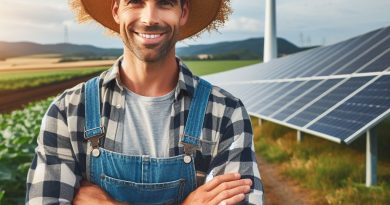Hydroponics: Future of Sustainable Farming?
Last Updated on December 18, 2023
Introduction
Hydroponics, a soilless cultivation method, revolutionizes farming by optimizing resource use.
Unveiling the potential of hydroponics
- Drastic water conservation.
- Enhanced nutrient efficiency.
- Year-round crop production.
- Minimized environmental impact.
- Space-efficient, urban farming solution.
What is hydroponics?
Definition and basic concept
Hydroponics is a soil-less farming technique that allows plants to grow using a nutrient-rich water solution.
It involves growing plants in a controlled environment, without the use of soil.
The basic concept is to provide plants with the necessary nutrients directly in their water supply.
Brief history and development
Hydroponics has been practiced for thousands of years, with evidence dating back to the Hanging Gardens of Babylon.
The Aztecs were also known to have used a form of hydroponics in their agriculture.
However, the modern development of hydroponics began in the 19th century with the experiments of German botanists.
In the 1930s, the first commercial hydroponic systems were developed, primarily for growing vegetables.
Since then, hydroponics has continued to evolve, with advancements in technology and research.
Today, hydroponics is utilized worldwide in various settings, including commercial farming, research facilities, and even personal home gardens.
The benefits of hydroponics are numerous, making it a promising solution for sustainable farming in the future.
Read: Conservation Tillage: Saving Soil and Water
Benefits of hydroponics
Water efficiency
Hydroponics uses significantly less water compared to traditional soil-based farming methods.
The water is recirculated within the system, minimizing water waste and reducing overall consumption.
Space efficiency
Hydroponics allows for vertical farming, making the most of limited space in urban areas.
Multiple layers of plants can be grown within a single system, maximizing productivity per square foot.
Nutrient control
In hydroponics, nutrients are delivered directly to the plants’ roots, ensuring optimal absorption.
This precision allows for better control over nutrient levels, resulting in healthier and faster-growing plants.
Pest and disease management
Without soil, hydroponics reduces the risk of pests and diseases that are commonly associated with traditional farming.
This eliminates the need for pesticides and other chemical treatments, making it an eco-friendly option.
Year-round cultivation
Hydroponics provides a controlled environment, allowing for year-round cultivation regardless of climate conditions.
Plants can be grown in any season, ensuring a consistent and reliable food supply.
Current applications of hydroponics
Commercial farming
Hydroponics is increasingly being adopted by commercial farmers for large-scale crop production.
It offers higher yields, shorter growth cycles, and greater control over the quality and quantity of produce.
Urban farming
As urbanization continues to increase, hydroponics offers a viable solution for food production in cities.
Vertical farming systems can be implemented in unused spaces such as rooftops and unused buildings.
Research and experimentation
Hydroponics is widely used in research institutions for scientific studies related to plant biology and agriculture.
It allows scientists to control variables and observe plant responses in a controlled environment.
Home gardening
Hydroponics has become popular among home gardeners due to its convenience and efficiency.
Compact systems are available for growing herbs, vegetables, and even flowers indoors.
In short, hydroponics is an innovative farming technique with numerous advantages for sustainable agriculture.
Its water and space efficiency, precise nutrient control, and year-round cultivation potential make it a promising method for the future.
As it continues to evolve and be adopted in various applications, hydroponics has the potential to transform the way we grow food.
Read: Integrated Pest Management: Eco-Friendly Tactics
Advantages of Hydroponics
Hydroponics is gaining attention as a promising solution for sustainable farming. Let’s explore its advantages:
Water and Resource Conservation
One of the major advantages of hydroponics is its ability to conserve water and resources.
Traditional agriculture methods use large amounts of water for irrigation, losing significant quantities to evaporation and runoff.
In hydroponics, water is recirculated and reused, resulting in up to 90% less water consumption compared to conventional farming.
Efficient Use of Space
Space is a valuable resource, especially in urban areas where land availability is limited.
Hydroponics solves this problem by allowing plants to be grown vertically, utilizing vertical space effectively.
By growing crops in stacked layers or towers, hydroponic systems enable farmers to maximize productivity and harvest more crops per square meter.
No Need for Soil
Another advantage of hydroponics is the absence of soil. Instead, plants are grown in nutrient-rich water solutions, providing all the necessary elements for their growth.
Without soil, the risk of soil-borne diseases and pests is eliminated, resulting in healthier plants and higher yields.
Greater Control over Plant Growth
Hydroponic systems offer precise control over various growth factors, such as nutrient intake, pH levels, and light exposure.
By monitoring and adjusting these parameters, farmers can create optimal growing conditions for their crops.
This level of control leads to faster growth, healthier plants, and higher yields.
Reduced Use of Pesticides and Chemicals
In traditional agriculture, pesticides and chemicals are often used to control pests and diseases.
However, these substances can be harmful to both the environment and human health.
With hydroponics, the risk of pests and diseases is significantly reduced due to the absence of soil.
As a result, farmers can minimize the use of chemicals and pesticides, making hydroponics a more sustainable and eco-friendly farming method.
Overall, hydroponics offers several advantages that make it a promising solution for sustainable farming.
Its ability to conserve water and resources, efficient use of space, elimination of soil-related risks, greater control over plant growth, and reduced reliance on pesticides and chemicals contribute to a more sustainable and environmentally friendly approach to agriculture.
By embracing hydroponics, we can move towards a future of farming that is both productive and sustainable.
Read: Cover Crops: Protecting and Nourishing Soil
Challenges in Hydroponics
Initial Setup Costs
- Hydroponic systems require a significant initial investment in infrastructure and equipment.
- Expenses include setting up a controlled environment, installing grow lights, and purchasing nutrient solutions.
- The cost of suitable equipment and materials can be a barrier for small-scale farmers or beginners.
- Financial planning and budgeting are essential to ensure a successful hydroponic operation.
Maintaining Proper Nutrient Balance
- Achieving and maintaining the correct nutrient balance is crucial for plant growth and productivity.
- Careful monitoring of nutrient levels, pH, and electrical conductivity is necessary to avoid imbalances.
- Nutrient deficiencies or excesses can lead to stunted growth, nutrient lockout, or even plant death.
- Regular testing and adjustment of nutrient solutions are required to ensure optimal plant health.
Risks Associated with System Failures
- Hydroponic systems rely on various components like pumps, timers, and sensors, which can malfunction.
- Power outages or equipment breakdowns can disrupt the proper functioning of the hydroponic system.
- System failures can lead to inadequate water or nutrient supply, resulting in crop loss or reduced yields.
- Regular maintenance, backup systems, and contingency plans are necessary to mitigate these risks.
Limited Crop Variety
- Hydroponics is well-suited for growing leafy greens, herbs, and some vegetables, but not all crops.
- Certain plants may not thrive in hydroponic systems due to specific growth requirements or root structures.
- For example, crops with deep taproots or those that require extensive space may not be suitable for hydroponics.
- Lack of crop diversity can limit the marketability and profitability of hydroponic farms.
Despite these challenges, hydroponics presents an innovative and sustainable approach to farming.
By addressing the initial setup costs, farmers can secure long-term benefits and returns on investment.
Proper training and education are essential for farmers to understand nutrient requirements and ensure balanced growth.
Regular maintenance schedules, as well as backup systems, minimize the risks associated with system failures.
Researchers and experts continue to explore ways to expand the range of crops suitable for hydroponic cultivation.
In fact, while hydroponics faces challenges, its potential as a future sustainable farming method is undeniable.
The ability to grow food in urban settings, conserve water, and reduce reliance on conventional agricultural practices is significant.
With continued advancements and knowledge sharing, hydroponics can revolutionize the way we produce our food.

Applications of hydroponics in sustainable farming
Urban farming and vertical agriculture
Hydroponics is ideal for urban areas, allowing people to grow food in limited spaces.
The vertical farming technique maximizes space utilization in urban environments.
It helps address food security concerns by providing fresh produce locally.
Food production in non-arable areas
Hydroponics is a game-changer in non-arable regions, such as deserts or rocky terrains.
By using water-based nutrient solutions, crops can thrive without soil and traditional farming methods.
It offers a sustainable solution to these areas, ensuring reliable food production.
Year-round crop production
With hydroponics, farmers can overcome season limitations and produce crops throughout the year.
Controlling the environment allows for optimum growth regardless of external factors like weather.
This ensures a constant and stable food supply, reducing reliance on imports.
Eco-friendly farming practices
Hydroponics promotes eco-friendly farming practices by reducing water usage significantly.
Compared to traditional soil-based farming, hydroponics uses 90% less water.
It minimizes the need for harmful pesticides, resulting in cleaner and safer food production.
Hydroponics drives sustainable farming:
- Empowers urban and vertical agriculture, overcoming limited land availability.
- Maximizes space through vertical farming, addressing food security by promoting local, transport-efficient produce.
- Revolutionizes food production in non-arable areas, thriving without soil, benefitting harsh environments.
- Enables year-round crop production, offering control over temperature, light, and nutrient levels.
- Aligns with eco-friendly practices, using up to 90% less water, minimizing pesticide use, ensuring cleaner, safer produce.
In essence, hydroponics is pivotal for sustainable farming, from urban solutions to non-arable regions, promoting resilience and eco-conscious practices.
Successful examples of hydroponics in sustainable farming
The Plant – Chicago, IL
The Plant in Chicago, Illinois is an outstanding example of hydroponics being used in sustainable farming.
It is a former meatpacking facility that has been transformed into a vertical farm and food business incubator.
It utilizes hydroponic systems to grow a wide variety of vegetables, herbs, and microgreens.
The hydroponic systems at The Plant are designed to maximize efficiency and sustainability.
They use advanced techniques such as nutrient film technique (NFT) and deep water culture (DWC) to provide the plants with a constant supply of nutrients and water.
This allows for faster growth and higher yields compared to traditional soil-based farming methods.
One of the most innovative aspects of The Plant is its closed-loop system. The facility incorporates aquaponics, which combines hydroponics with fish farming.
The waste produced by the fish is used as fertilizer for the plants, creating a sustainable and symbiotic relationship between the two systems.
Lufa Farms – Montreal, Canada
Lufa Farms in Montreal, Canada is another successful example of hydroponics in sustainable farming.
This Farm operates the world’s first commercial rooftop greenhouse, utilizing hydroponic systems to grow fresh produce year-round.
The rooftop greenhouse system allows Lufa Farms to make the most of available space in urban areas, reducing the need for land-intensive farming practices.
The hydroponic systems used by Lufa Farms are energy-efficient, using less water and nutrients compared to traditional agriculture.
Lufa Farms also implements a direct-to-consumer model, delivering freshly harvested produce directly to customers’ homes.
By eliminating intermediaries, they reduce food waste and ensure that customers receive the highest quality produce.
This innovative approach not only benefits the environment but also supports local communities.
Growing Underground – London, UK
Growing Underground in London, United Kingdom, showcases how hydroponics can be used to transform urban spaces into productive farms.
It utilizes disused tunnels beneath the city to grow a variety of crops using hydroponic systems.
The underground location provides a controlled environment for crop production, free from the limitations of weather conditions and pests.
The hydroponic systems enable precise control over nutrient levels and water usage, resulting in optimal plant growth and resource efficiency.
Growing Underground’s close proximity to markets reduces transportation distances, minimizing carbon emissions associated with food distribution.
By transforming unused spaces into productive farms, Growing Underground demonstrates the potential for hydroponics to revolutionize urban agriculture and promote sustainability.
These successful examples of hydroponics in sustainable farming illustrate the potential of this innovative technique to address the challenges faced by traditional agriculture.
By maximizing resource efficiency, reducing environmental impacts, and ensuring year-round crop yield, hydroponics offers a promising solution for sustainable food production.
These case studies highlight the diverse applications of hydroponics, from repurposed buildings to rooftop greenhouses and underground tunnels.
Each example demonstrates the adaptability and scalability of hydroponic systems, showing that sustainable farming is not limited by traditional constraints.
As the global population continues to grow, the need for efficient and sustainable food production becomes increasingly urgent.
Hydroponics has the potential to play a crucial role in meeting this demand while minimizing environmental impacts.
These success stories should inspire more widespread adoption of hydroponics in agriculture, paving the way for a greener and more sustainable future.
Read: Cover Crops: Protecting and Nourishing Soil
Future prospects
Increasing adoption and acceptance
Hydroponics, the innovative method of growing plants without soil, is gaining traction worldwide.
The increasing awareness about its numerous benefits is leading to a steady rise in its adoption rate.
Farmers and agriculturalists are realizing the potential of hydroponics in maximizing crop yields.
The acceptance of this sustainable farming practice is growing among both urban and rural communities.
Governments and organizations are actively promoting hydroponics as an efficient solution for food production.
Technological advancements
The evolution of technology is further enhancing the future prospects of hydroponics.
Advanced techniques such as vertical farming and aeroponics are revolutionizing the way plants are grown.
Sophisticated monitoring systems allow precise control over factors like temperature, light, and nutrient levels.
Automation and AI-driven solutions are streamlining hydroponic operations, reducing labor and boosting efficiency.
New developments in lighting technologies, such as LED grow lights, are improving plant growth and energy efficiency.
Integration with other sustainable farming practices
The integration of hydroponics with other sustainable farming practices opens up possibilities for even greater environmental benefits.
Combining hydroponics with aquaponics, where fish waste provides nutrients for plants, creates a symbiotic ecosystem.
Integrating hydroponics with organic farming methods can result in pesticide-free produce with higher nutritional value.
Hydroponics can also complement rooftop gardens, urban agriculture, and community farming initiatives.
This integration promotes a holistic approach to sustainable food production and resource utilization.
Potential impact on global food security
The future prospects of hydroponics have significant implications for global food security.
As the world population continues to grow, traditional farming methods are facing challenges in meeting the rising demand for food.
Hydroponics presents a viable solution to address this issue by enabling year-round crop production in controlled environments.
Its space-efficiency allows cultivation in urban areas, reducing the need to transport food over long distances.
Additionally, hydroponics requires significantly less water compared to traditional farming, conserving a scarce resource.
Overall, the future of hydroponics appears promising due to increasing adoption and acceptance.
Technological advancements are pushing the boundaries of this sustainable farming practice.
Integration with other eco-friendly farming methods enhances its environmental benefits.
Furthermore, hydroponics has the potential to contribute significantly to global food security.
As we embrace the future, hydroponics may revolutionize the way we grow food, sustainably and efficiently.
Read: Natural Pest Control: Chemical-Free Farming
Conclusion
Hydroponics has shown great potential in sustainable farming, providing numerous benefits like water conservation and increased crop yields.
It is important to encourage further research and development in hydroponics to optimize its techniques and expand its applications in agriculture.
In closing, hydroponics presents a promising solution for sustainable farming.
By growing plants without soil and using nutrient-rich water solutions, this method conserves water, reduces the need for pesticides, and significantly increases crop yields.
Moreover, hydroponics systems can be set up in small spaces, making it a viable option for urban farming and food production.
Through the use of technology, growers can closely monitor and control environmental factors such as pH levels, temperature, and light intensity, creating an ideal growing environment for plants.
This precision allows farmers to maximize production while minimizing resource usage.
Furthermore, hydroponics eliminates the risk of soil-borne diseases and pests, reducing the need for harmful chemical treatments.
While hydroponics has already demonstrated its effectiveness, further research and development are essential to unlock its full potential.
Scientists and agricultural experts should explore different growing mediums, improve nutrient delivery systems, and optimize cultivation techniques to achieve even better results.
Additionally, collaboration between researchers, farmers, and entrepreneurs can lead to innovation in system design and automation, making hydroponics more accessible and cost-effective for all.
Investment in hydroponics research and development can pave the way for a sustainable future of farming.
The integration of this technology into mainstream agriculture has the potential to address the challenges posed by climate change, population growth, and resource scarcity.
By embracing hydroponics and continually advancing its techniques, we can strive towards a more sustainable and secure food production system for future generations.


